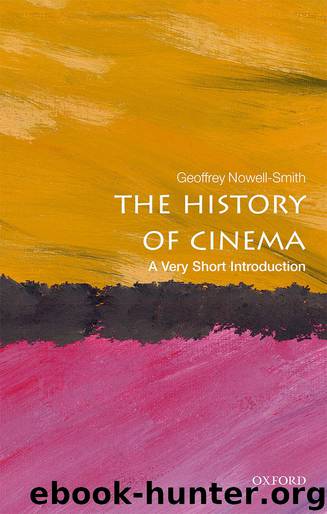The History of Cinema: A Very Short Introduction by Geoffrey Nowell-Smith

Author:Geoffrey Nowell-Smith
Language: eng
Format: epub
ISBN: 9780191005237
Publisher: OUP Oxford
Published: 2017-09-15T04:00:00+00:00
Sound cinema
The coming of synchronized sound around 1930 did not immediately change basic storytelling techniques, but it changed just about everything else. Most obviously, it added dialogue, which tended, at least in the early years of the expanded medium, to be quite theatrical. It altered the rhythm of films, making them faster because they were no longer encumbered by intertitles. With the need to match not only action but dialogue, editing became even more of a fine art.
Where synchronized sound did affect storytelling was by making it much easier to structure stories with a complex time frame. In the late 1930s and 1940s there was a vogue for telling stories mainly in flashback, with a series of scenes from the past being used to explain a present enigma posed at the outset of the film. Why in Orson Welles’s Citizen Kane (1941) does the dying Kane whisper the word ‘Rosebud’, or why does Lisa’s voice-over at the beginning of Letter from an Unknown Woman cryptically announce, ‘By the time you get this letter I may be dead’? Usually in such stories the enigma is resolved, but in later films such as Alain Resnais’ Last Year in Marienbad (1960) the dual time frame leaves matters in doubt as hero and heroine continue to disagree as to what did or did not happen in Marienbad the year before.
As well as dialogue, synchronized sound also brought with it the integration of music into the fabric of the film, either as background or, in the case of the musical, as the centrepiece of the film itself. No longer was music an addition to the film, dependent on the resources available to theatre managers and the resident pianist or orchestra. Now every element of the score could be thought out and minutely cued in advance, and would be the same wherever the film was shown.
Musicals used popular show tunes for song-and-dance numbers, but the prevailing style in Hollywood for music as an accompaniment to the drama was derived from the 19th-century Romantic tradition and performed by the studio’s in-house symphony orchestra. Distinctively 20th-century styles of classical music using smaller (and cheaper) ensembles appeared from time to time in European films and in documentary, while outside Europe film scores tended to mix elements from native and Western traditions.
Generally the purpose of film music was to add emotional colouring to the drama, but it could also be integrated into the narrative. Max Steiner’s score for Casablanca (1942) provides a classic example, incorporating patriotic music (the ‘Marseillaise’) and a sentimental song (‘As Time Goes By’, associated with the Ingrid Bergman character) into its generally lush symphonic scoring.
Music for emotional colouring continued to dominate film music even after the symphonic score fell out of favour from the 1960s, to be replaced by a variety of modes, including the discreet use of modernist motifs on the one side and the incorporation of rock music on the other. Modern music tracks (they are not always scores in the traditional sense) are in fact extremely eclectic.
Download
This site does not store any files on its server. We only index and link to content provided by other sites. Please contact the content providers to delete copyright contents if any and email us, we'll remove relevant links or contents immediately.
| Coloring Books for Grown-Ups | Humor |
| Movies | Performing Arts |
| Pop Culture | Puzzles & Games |
| Radio | Sheet Music & Scores |
| Television | Trivia & Fun Facts |
The Kite Runner by Khaled Hosseini(5084)
Gerald's Game by Stephen King(4583)
Dialogue by Robert McKee(4323)
The Perils of Being Moderately Famous by Soha Ali Khan(4169)
The 101 Dalmatians by Dodie Smith(3454)
Story: Substance, Structure, Style and the Principles of Screenwriting by Robert McKee(3397)
The Pixar Touch by David A. Price(3364)
Confessions of a Video Vixen by Karrine Steffans(3246)
How Music Works by David Byrne(3187)
Fantastic Beasts: The Crimes of Grindelwald by J. K. Rowling(2994)
Harry Potter 4 - Harry Potter and The Goblet of Fire by J.K.Rowling(2990)
Slugfest by Reed Tucker(2942)
The Mental Game of Writing: How to Overcome Obstacles, Stay Creative and Productive, and Free Your Mind for Success by James Scott Bell(2845)
4 - Harry Potter and the Goblet of Fire by J.K. Rowling(2656)
Screenplay: The Foundations of Screenwriting by Syd Field(2576)
The Complete H. P. Lovecraft Reader by H.P. Lovecraft(2514)
Scandals of Classic Hollywood: Sex, Deviance, and Drama from the Golden Age of American Cinema by Anne Helen Petersen(2465)
Wildflower by Drew Barrymore(2443)
Robin by Dave Itzkoff(2385)
